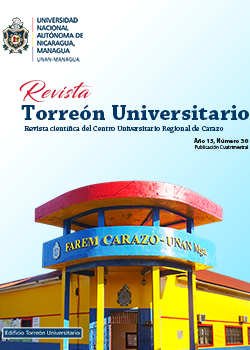Dynamics of production, unemployment, and inflation in Nicaragua, period 2012 – 2022 and prospects 2026
DOI:
https://doi.org/10.5377/rtu.v13i38.19315Keywords:
Macroeconomics, Production, Unemployment, Inflation, Human DevelopmentAbstract
Achieving human development and fighting poverty is the challenge posed in Nicaragua in the period 2022-2026, contemplated in 12 strategic lines: 1) Macroeconomic stability, 2) Reinforce the basic conditions of development; 3) Development of human talents; 4) Public goods and services, for social welfare 5) Deepen equality between genders 6) Youth central axis of development; 7) Improve production in the field; 8) Develop creative economy, 9) Revitalize trade and local and international markets; 10) Inclusive cities, neighborhoods and counties; 11) Measures to mitigate climate change; 12) The Caribbean Coast special zone of human and socioeconomic development. As axes of the purpose, three indicators are analyzed: GDP Gross Domestic Product, Inflation and Unemployment Rate, using time series of the period 2012 - 2022. It is objective to recognize that, during this period, the country was affected by different crises, including world order, which overlapped; such as the one caused in 2018, the health crisis that affected the country since 2020 and the crisis due to the new world order, consecutively and that seriously affected aspects such as the supply chain, the capacities of health systems to deal with the pandemic and international inflation, to mention a few facts; These situations came and caused serious price rises and shortages. However, the country shows a resilient economic behavior; Studying its indicators will allow decisions to continue the fight for economic development.
Downloads
References
Avendaña, N. (2020). El Pensamiento de un post Keynesiano. pág. https://nestoravendano.wordpress.com/.
BCN. (2021). Informe Anual. Obtenido de hppt://www.bcn.gob.ni
BCN. (2022). Anuario de Estadisticas Macroeconómicas. Managua, Nicaragua.
Blanchard, O., Amighini, A., y Giavazzi, F. (2012). Macroeconomía. Madrid: Pearson Educación S.A.
Fernández, J. (2008). Reexpresión de estados Fiancieros en Venezuela. Revista Venezolana de Gerencia.
GRUN. (2018). Plan Nacional de Desarrollo Humano.
GRUN. (2022). Plan Nacional del Lucha Contra la Pobreza y para el Desarrollo Humano 2022 - 2026.
Hernández Sampieri, R. (2014). Metodología de la Investigación. Colombia: McGRAW-HILL / INTERAMERICANA EDITORES, S.A. DE C.V.
MEFCCA. (2020). MEFCCA apunta al fortalecimiento de las PYMES en Nicaragua. Obtenido de https://www.economiafamiliar.gob.ni/websitemefcca-mvc/noticia-mefcca-apunta-fortalecimiento-pymes-nicaragua/526
Méndez Álvarez, C. E. (2006). Metodologia. Limusa.
ONU. (2015). Organización de las Naciones Unidas. Obtenido de Acabar con la pobreza: https://www.un.org/es/sections/issues-depth/poverty/index.html
Parkin , M., Esquivel, G., y Muñoz, M. (2007). Macroeconomía. México: Pearsón Educación.
Virrareal, F. (2016). Introducción a los Modelos de Pronósticos. Obtenido de www.matematica.uns.edu.ar/uma2016/material/Introduccion_a_los_Modelos_de_Pronosticos.pdf
Yanes, y Cano. (2012). Tipología del desempleo: un análisis a través de la Curva de Beveridge. Obtenido de http://www.redalyc.org/articulo.oa?id=194224362012
Downloads
Published
Issue
Section
License
Copyright (c) 2024 National Autonomous University of Nicaragua, Managua

This work is licensed under a Creative Commons Attribution-NonCommercial-NoDerivatives 4.0 International License.
The authors who publish in this journal agree to the following terms.
- The author or authors of the articles, essays or research grant the National Autonomous University of Nicaragua, Managua (UNAN-Managua) the editing rights (copyright) of the submitted work, therefore the University has the exclusive right to publish the article for the entire copyright period.
- These copyrights/authors authorize Torreón Universitario Magazine and the University to edit and disseminate/publish the article in said Magazine, including printed and electronic reproduction, storage, retrieval and any other type of publication, and sources of secondary information as services. of summaries and databases, they also empower it to protect the article against unauthorized use for dissemination by printed or electronic media (PDF, HTML, EPUB, XML or others).
License for use of content
The magazine uses the Creative Commons Attribution-NonCommercial-NoDerivs 4.0 International License.
Under this statement:

This journal is licensed under a Creative Commons Attribution-NonCommercial-NoDerivatives 4.0 International License. It can be copied, distributed and transmitted publicly as long as the author and source are cited (Revista Torreón Universitario), it should not be modified or used for any commercial purpose. The full license can be found at http://creativecommons.org/licenses/by-nc-nd/4.0/.



